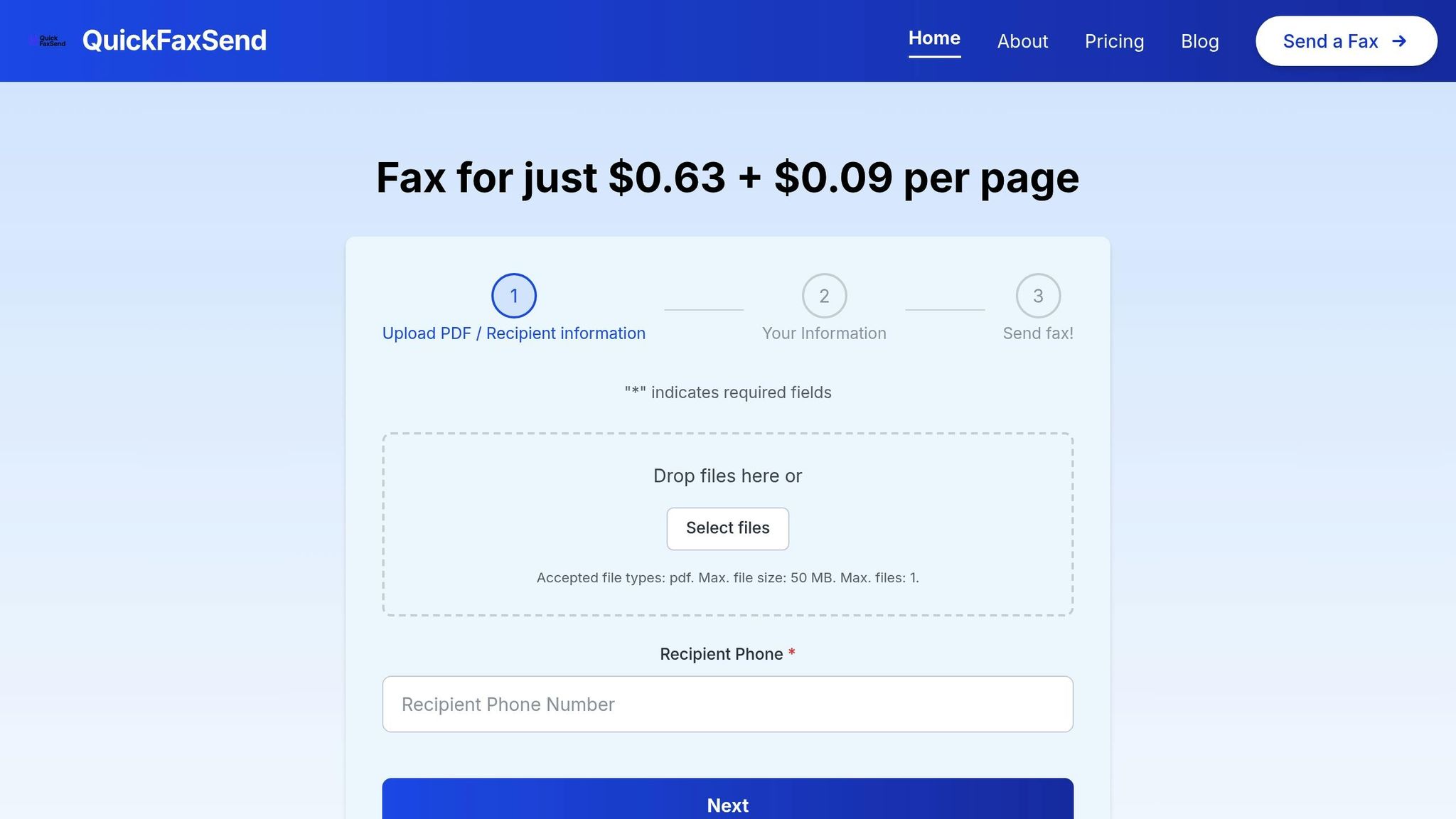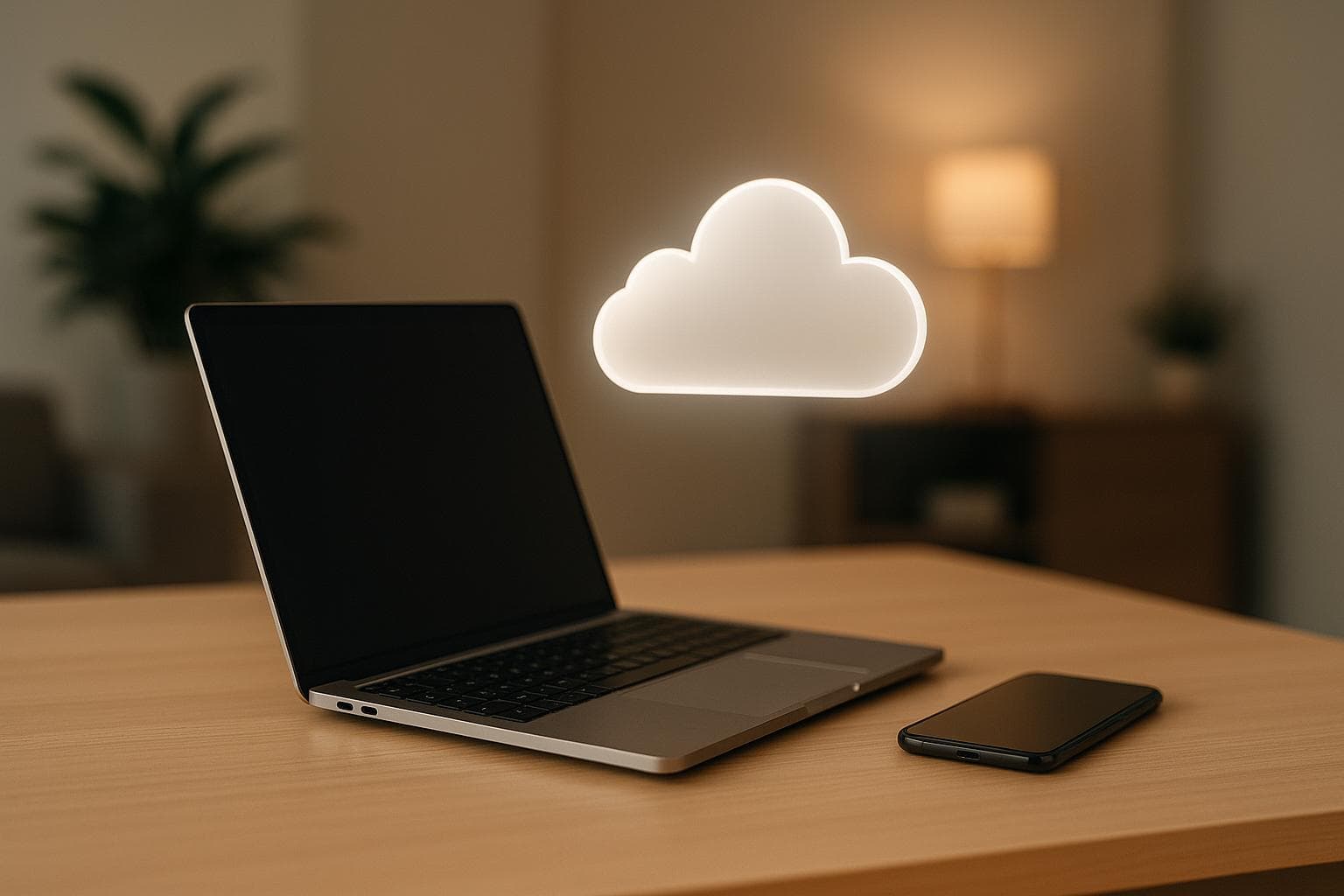Cloud Faxing: Eliminate Equipment Costs
Faxing without the hassle of machines? It's possible. Cloud faxing moves your faxing needs online, cutting out expensive equipment, maintenance, and supplies. Here's why it makes sense:
- No hardware needed: Skip buying fax machines or multi-function printers.
- No recurring costs: Eliminate paper, ink, toner, and dedicated phone lines.
- Pay-as-you-go pricing: Only pay for the faxes you send.
For example, services like QuickFaxSend let you send a three-page fax for just $0.90, compared to the ongoing costs of maintaining a machine. It's cost-efficient, simple, and fits today's remote work environment.
Switching to cloud faxing can save money, time, and space. Read on to see how it works and why it's a smart move for businesses.
4 Reasons to Offer Virtual Fax Solutions
::: @iframe https://www.youtube.com/embed/UKHDfdTpjGY :::
What Traditional Faxing Really Costs
At first glance, traditional faxing might seem like a cost-effective option. But when you dig deeper, the ongoing expenses can quickly pile up, revealing a much heftier price tag over time.
Upfront Equipment Costs
The initial investment in fax equipment is no small matter. A basic fax machine can cost anywhere from $50 to $150, but these typically offer limited features. If you’re looking at mid-range models, expect to pay between $150 and $300, while high-end machines start at $300 and can easily exceed $500. Professional-grade devices? Those can range from $500 to over $1,000 [3][4][5].
For businesses, multi-function printers (MFPs) with fax capabilities are a popular choice. Basic MFPs generally cost $100 to $300, while more advanced models are priced between $150 and $300. On the higher end, enterprise-level MFPs with integrated fax functions can soar to $4,000 [2].
Here’s a quick breakdown of equipment costs:
| Equipment Type | Price Range | Best For | | --- | --- | --- | | Basic Fax Machines | $50 - $150 | Light personal use | | Mid-Range Fax Machines | $150 - $300 | Small businesses | | High-End Fax Machines | $300 - $500+ | Heavy business use | | Basic MFPs | $100 - $300 | Small offices | | Professional MFPs | $500 - $4,000 | Large organizations |
On top of these purchase prices, professional setup and installation - especially when integrating the machine into existing systems - can tack on additional costs [1].
Recurring Maintenance and Supply Costs
The expenses don’t stop once the machine is set up. Traditional faxing comes with ongoing costs like paper, toner, and ink. Many businesses also require a dedicated phone line for faxing, which adds a monthly fee to the mix. Factor in routine maintenance and occasional repairs, and the total cost of ownership starts to climb.
These operational costs can be a constant drain on resources, especially for businesses that rely heavily on faxing.
Compliance and Security Expenses
For industries like healthcare and finance, the costs don’t end with maintenance. Regulatory requirements, such as HIPAA compliance, introduce additional expenses. Organizations often need to invest in secure document storage, implement document management systems, and even enhance physical security for areas housing fax equipment. These measures are crucial for protecting sensitive information but can significantly increase operational costs.
When you add it all up, traditional faxing is far from the low-cost solution it might initially appear to be.
How Cloud Faxing Cuts Equipment Costs
Switching to cloud faxing helps businesses save big by cutting out the need for expensive equipment, making operations more cost-effective.
Cloud faxing shifts the entire faxing process online. Instead of relying on bulky machines and dedicated phone lines, this system uses secure internet connections and web-based platforms to handle fax transmissions. This change eliminates many of the expenses tied to traditional faxing.
Say Goodbye to Hardware Expenses
One of the biggest perks of cloud faxing is that it removes the need to buy and maintain costly equipment. You no longer need to invest in fax machines, multi-function printers, or dedicated phone lines. Instead, everything runs seamlessly on devices you already own, like computers, tablets, or smartphones.
With cloud faxing, documents are digitally converted into a fax-friendly format and securely sent over the internet. The entire process is handled through remote servers, giving you access to professional faxing capabilities without the hefty price tag of hardware. This means you save on both the upfront costs of equipment and the ongoing expenses of maintaining it.
No More Supply Expenses
Cloud faxing also eliminates recurring costs like paper, toner, and ink. Since faxes are sent digitally, you won’t need to stock up on these supplies. Plus, there’s no need for dedicated phone lines, further reducing expenses. These savings not only cut costs but also add convenience and flexibility to your operations.
Flexible Pay-Per-Use Pricing
Another major financial benefit of cloud faxing is its pay-per-use pricing model. Instead of making large upfront investments or committing to fixed monthly fees, you only pay for the faxes you actually send. This approach aligns costs with usage, making it a budget-friendly alternative to traditional faxing. Together, these advantages make cloud faxing a smart and cost-effective choice for businesses.
sbb-itb-7cae838
Other Financial Benefits of Cloud Faxing
Switching to cloud faxing isn't just about convenience - it also brings a range of cost-saving opportunities that can positively impact your bottom line over time.
Lower Energy and Space Costs
Traditional fax machines are notorious for their energy consumption. Even when idle, they draw power continuously, and their functions - like printing and scanning - consume even more electricity. This constant energy use not only drives up utility bills but also increases carbon emissions [6][7][9].
Cloud faxing eliminates this drain. Instead of relying on power-hungry machines, it operates via energy-efficient data centers designed to reduce both electricity usage and environmental impact [7][8][9]. By cutting out the need for always-on hardware, businesses can significantly lower their monthly energy costs.
And it doesn’t stop there. Removing traditional fax machines also frees up precious office space [6]. In areas where commercial real estate is expensive, reclaiming that space can lead to further savings. Whether you downsize your office or repurpose the extra room for more productive uses, the financial benefits are clear.
Easy Scaling Without Extra Hardware
Cloud faxing platforms make it simple to scale your faxing needs without requiring additional hardware or upfront investments [10][11]. This means businesses can easily adjust the number of fax lines or handle sudden spikes in usage - like during seasonal peaks - without worrying about buying new equipment or finding more space to accommodate it [9].
Whether you're ramping up operations or scaling down during quieter times, cloud faxing ensures you can adapt quickly and efficiently. Unlike traditional systems that demand costly upgrades and added infrastructure, cloud faxing eliminates these hurdles, keeping your workflows smooth and your costs under control [10][11].
QuickFaxSend: Simple and Affordable Cloud Faxing

QuickFaxSend shows how cloud faxing can simplify and modernize the way you send faxes. Say goodbye to bulky fax machines and maintenance costs - this digital solution works seamlessly on any device.
What QuickFaxSend Brings to the Table
With QuickFaxSend, both businesses and individuals can send faxes directly from their devices. It supports PDF uploads to maintain your document's original formatting and uses a "Smart Delivery" system to ensure your fax is sent with delivery confirmation [12].
Straightforward Pricing
QuickFaxSend uses a pay-as-you-go pricing model - no subscriptions or hidden fees. Sending a fax costs $0.63, with an additional $0.09 per page [12]. For example, a 3-page fax totals just $0.90.
User-Friendly for Everyone
No special equipment or technical know-how is needed. Just upload your PDF, input the recipient's fax number, and hit send. QuickFaxSend takes care of the rest, including formatting and delivery confirmation. Plus, its web interface allows you to track your fax history from any browser with ease.
Conclusion: Switch to Cloud Faxing and Save Money
The facts are clear - traditional fax machines are a drain on your budget. Between the upfront cost of the equipment, regular maintenance, constant supply needs, and energy usage, the expenses quickly add up. Cloud faxing, on the other hand, wipes out these costs while offering better features and enhanced security.
By switching to cloud faxing, you can streamline your workflow and cut down on expenses. Say goodbye to repair delays, running out of supplies, or dealing with outdated hardware. Cloud faxing is flexible and scales to fit your business needs effortlessly.
Take QuickFaxSend as an example of how cost-effective cloud faxing can be. With its transparent pay-as-you-go pricing, you’ll only pay $0.63 per fax, plus $0.09 for each additional page. Sending a three-page business document costs just $0.90 - far less than the ongoing expenses of maintaining a traditional fax machine.
The process couldn’t be simpler. Just upload your PDF, enter the recipient’s fax number, and hit send. Your document is delivered securely, with confirmation and tracking available from any web browser. It’s faxing, but designed for the modern workplace.
Switching to cloud faxing means immediate savings, greater reliability, and the flexibility to grow alongside your business. Make the move today and see how it transforms your bottom line.
FAQs
::: faq
How does cloud faxing keep sensitive documents secure and ensure compliance with regulations?
Cloud faxing relies on encryption technologies to keep sensitive documents safe during both transmission and storage. This minimizes the chances of unauthorized access or potential data breaches. With tools like AES encryption in place, your information remains private and protected.
On top of that, many cloud faxing services are built to meet regulatory standards like HIPAA, ensuring that sensitive data is managed securely and in line with legal obligations. These robust security features make cloud faxing a trustworthy and safer option compared to traditional faxing methods. :::
::: faq
What challenges might businesses face when switching from traditional faxing to cloud-based faxing?
Switching from traditional faxing to a cloud-based system isn’t always a walk in the park. For starters, businesses might need to dedicate time to train employees on how to use the new platform. Security and compliance concerns, especially with regulations like HIPAA, could also require extra attention to ensure everything is up to standard. On top of that, there are often upfront expenses tied to migrating data and integrating the cloud fax service into existing processes.
Some employees might be hesitant to embrace the change, particularly if they’re comfortable with the old way of doing things. And let’s not forget potential technical hiccups - like ensuring a reliable internet connection or making sure the new system plays well with current tools and workflows. That said, with thoughtful planning and the right support, these obstacles can usually be smoothed out, leading to a more streamlined and cost-efficient faxing solution in the long run. :::
::: faq
How does pay-as-you-go pricing work for cloud faxing, and how can businesses estimate their costs?
The pay-as-you-go pricing model for cloud faxing is straightforward: you’re charged only for the faxes you send. Typically, this involves a small fee per page or per fax, making it a flexible and budget-friendly option for businesses that don’t have consistent faxing needs. Plus, there’s no need to commit to monthly subscriptions or long-term contracts.
To get a handle on costs, businesses can estimate their average monthly fax volume - how many pages they send - and multiply that by the per-page rate. This method makes it easy to plan your faxing budget while avoiding unnecessary expenses or surprises. :::
